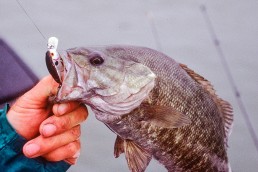Spring Tackle Checkup Checklist
SHARE THIS POST
The throbbing rod told me a fish had nailed my crankbait. After a short but strong fight, a two-foot-long pickerel showed itself. Ick, not the species I wanted! Not wanting to use the net and deal with tangled hooks or teeth in the mesh, I swung it aboard. While trying to remove the front treble from the fish, it flipped and buried the rear treble in the carpet. The fish flipped one more time, removing the rear hook from the carpet and burying it in my finger.
Who’s hooking who?
It was quite a predicament, a two-foot-long fish getting its second wind and fastened firmly to the forefinger on my left hand. After some maneuvering and a great amount of pain on my part, I unhooked the fish. Yes, it survived. The next step was to cut the hook off the crankbait. Try as hard as I could, no amount of teeth gritting, groaning and squeezing the cutters with all the strength in my right hand could cut through the treble hook.
So, I wore the lure to the hospital emergency room, trying to look inconspicuous with a Firetiger-colored squarebill crankbait firmly attached. Lesson learned, puny diagonal cutters like the ones used by electricians will not cut through the shank of a treble hook. Now I carry a more substantial compound cutter like the kind available in home centers. DeWalt’s 7.5-inch Compound Action Diagonal Pliers is one example. A non-compound option for the well-heeled angler is Cuda’s Titanium Bonded Fishing Pliers from Bass Pro Shops.
Are you really prepared for the worst?
Checking my first-aid kit after the hospital visit was a major disappointment. To my dismay, all of the bandages were ruined. Years of stowage in my boat and some moisture infiltration caused the adhesive to become a gooey mess. The gauze looked like a used baby diaper and the antiseptic salve was two years out of date. In fact, there was nothing in the kit sanitary enough to put on a wound.
Lesson learned, check the first-aid kit at least once a year and ensure the kit is waterproof. The simple way to do that is to enclose the kit in a zipper-style plastic bag or buy a waterproof kit. My choice is a zipper bag because of the cost, but an option is Pelican’s watertight case for around $50. Above all, make sure you add additional sunscreen like Neutrogena’s Ultra Sheer Dry-Touch 100+ sunscreen, extra NSAID (aspirin) pain-relief tablets of your choice, antiseptic salve and you might consider motion sickness relief tablets.
I hope you will never need a medical kit or hook-removal tools. If you do, it is comforting to know your supplies are adequate and current.
Float or die
Another extremely important item is safety equipment and floatation gear. On waters considered Coast Guard (USCG) navigable, boats from 16 to 26 feet have specific safety requirements for floatation gear and distress signals while local waters follow state regulations. The internet will have the latest state and USCG requirements.
Are you enjoying this post?
You can be among the first to get the latest info on where to go, what to use and how to use it!
Also, check life jackets and inflatables carefully for wear, seams or straps failing and mold. Repair or replace any suspicious gear.
Checkups for your gear
Easily remembered maintenance includes inspecting rods and their guides for damage and wear. It is time to clean and lubricate reels and spool new line on the last 50 yards. No need to change all of the line. Lightly used level wind reels can usually get by with a good wipe-down and lubrication on the spool bearings, handle and line guide worm drive. Heavily used reels should be disassembled, cleaned and lubed. Some anglers are up to the task and some are not. Those reels should be cleaned and lubed by a professional if necessary.
What about line, how long does it last? I make it a point to change the first 50 yards of mono or fluorocarbon at least every year. On heavily used reels, five or six times a year. Refill spools are drawer-kept in a room with nominal temperature and humidity. Most quality lines will last four to seven years under those conditions. Beyond that it seems to dry out, lose elasticity and take a set. If you do not trust it on the business end, use it as backing.
Braided line lasts for years. I have some spooled that is 10 years old. The only maintenance I do is to remove about five feet when the end becomes frayed. For stored braid, I am so confident with the shelf life that I do not bother to date it.
The take on trailers
You know the drill on trailers, check the tires for wear or damage, make sure the wheel bearings are lubricated, check the brakes and hydraulic actuator (if equipped), safety tie-downs front and back, and the running lights. Also, check the fluid level in each battery and the installed date of the starting battery. It could be nearing its end of life.
This short to-do list should get you on the water and back safely, with heavy emphasis on safety.
MWO
SHARE THIS POST
Did you enjoy this post?
You can be among the first to get the latest info on where to go, what to use and how to use it!
Darrell Taylor
Darrell Taylor has fished for more than 65 years. During the past 25 years, Taylor has generated more than 2,000 published articles, columns and fishing reports. His writings received 14 peer-level awards from outdoor writer organizations, including the Association of Great Lakes Outdoor Writers “Excellence in Craft” Golden Glow Award, their highest recognition.



